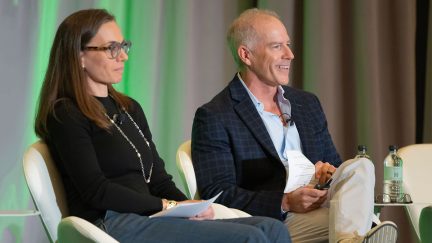For more stories like this, sign up for the PLANADVISERdash daily newsletter.
Marketing Tips for 401(k) Plan Professionals
Rebecca Hourihan, founder of 401(k) Marketing, offers suggestions to help advisory industry professionals feel more confident in their personal brand.
OneAmerica hosted a webinar this week featuring Sandy McCarthy, the firm’s president of retirement services, in conversation with Rebecca Hourihan, founder of 401(k) Marketing in San Diego.
The pair discussed the many marketing challenges facing advisory industry practitioners, with a particular focus on the added complexities of marketing as a woman in a field in which older white men are significantly overrepresented. The pair agreed that marketing is a challenge for all advisers, and one which is unfortunately all too often complicated by issues related to discrimination and stereotyping. However, with the right framework and strategies in hand, all advisers can use proven marketing tactics to grow and strengthen their business and their personal brand, they said.
“Our research shows women are eager to develop their careers in the retirement services field,” McCarthy explained. “Topics they want to hear about, and which we plan to cover in our ongoing webinar series, include self-branding, effective communications and navigating the impact of mergers and acquisitions [M&As].”
Given that she runs a marketing firm specifically dedicated to the 401(k) plan marketplace, it’s no surprise that Hourihan gives a pretty low assessment of the current state of affairs. In the industry’s defense, she notes, it has not been easy for advisers to engage in modernized marketing techniques, given the longstanding prohibitions put in place by the Securities and Exchange Commission (SEC). But these rules were recently overhauled, and, in some key respects, the most onerous restrictions on adviser advertising will soon be loosened, opening up the door for more sophisticated marketing efforts by financial professionals.
Recounted below are highlights from the webinar exploring some of these themes, complemented by materials published by Hourihan on her firm’s marketing blog.
Hourihan on the Way to Build a Personal Brand
It’s about building a strategic vision and action plan. Within your organization, you should take time to analyze and understand who you will need to get involved and engaged with your career, early on. If you look around, you can start to identify the potential road blocks or difficult conversations that you might be able to anticipate, and you can navigate them more effectively with planning and foresight.
We speak with our clients about how they can approach senior leadership early on in their career path, so that they already start to demonstrate their interest in advancement. These efforts can do a lot to generate buy-in and support from senior colleagues, and you will gain momentum as you begin to move through your career and to develop your own personal brand.
Chances are, these conversations about your goals and ambitious are not going to just involve one or two people or to happen just once. It’s about engaging with all of your colleagues and creating strong relationships and allies who will cheer you forward and who understand what you want to accomplish at work.
This stuff can happen faster than you think. If we are here speaking in the month of April right now, you can begin this work and ask yourself about your career goals. By May and June, you can be setting up these strategic discussions and pitching your vision about what you want to achieve. Tell your colleagues how you feel and why they should want to support your career growth. You might be surprised by the reception you get when you actually come forward and ask to be made a part of leadership and part of the working groups and study groups.
If you raise your hand over and over again to help on different projects, you will find yourself in the spotlight and with new opportunities. I’ve had clients who have been totally blown away by the change they’ve seen by stepping up this way—you can become the expert or the leader in a way that feels like it happens overnight.
Hourihan on What Makes a Personal Brand
Of course, it’s about embracing your passions and interest and making this the center of thoughtful leadership. You can be the one to start the blog, or to volunteer for the media experience, and to get your name and face out there. You will be building your own personal brand even as you support the company, and this is how real career progress can happen. When you are developing your personal brand, be unique, be relevant and be informative, but above all else, be yourself.
Hourihan on Website/Social Media Best Practices
First off, hire a professional photographer for headshots. As much as we love selfies, it’s worth taking the time to hire a professional.
My second tip is to dress the way you would normally dress for work. If you are going to a client meeting, what would you normally wear? If you are more of a business casual person in front of clients, your online persona should reflect this, or if you would always wear a suit for meetings, wear the suit in the photos.
Third and also really important, make an event out of it and have some fun. Bring your people together and try to enjoy the headshot and branding process together. It will show through in the photos.
While plan sponsors have been quietly using the internet to research service providers for over a decade, social distancing has made the need for a strong digital presence abundantly clear. Your website and social media profile are likely a prospect’s first impression of you and your firm. A professional-looking LinkedIn profile also goes a long way. Three ways to immediately enhance your profile include using an accurate profile picture that is less than three years old, adding a banner image that highlights your interests, and properly linking your companies in the experience section.
Finally, looking professional is only the first step. For social media to work, you have to join the conversation. This means publishing regular content, liking, commenting, sharing and joining groups.
Hourihan on the Importance of Email Marketing
Email is such a simple tool that it is often overlooked by advisers. You have the ability to do direct, one-to-one emailing for very targeted outreach, and then you have the ability to do bulk email sends, potentially in partnership with a vendor. Simply put, a lot of advisers still do not maximize the digital reach their email can have.
The first thing we do with our clients is to examine their “list.” We ask if they have an email list of clients, centers of influence, top prospects and anyone else in the business whom they have mutual respect for. Time and time again, they don’t have this fuller list, or at least it is way out of date. Putting together and updating this list can be a great first step, and you can aim for perhaps 500 contacts.
If that seems like a lot of people, you can leverage your LinkedIn profile to source email contacts and get your outreach up and running. Of course, you have to deliver value. You need to make sure that whatever content you are delivering is something that the recipients will be interested in.
Ultimately, building your personal brand via email is about demonstrating thought leadership and engagement, especially when you are communicating with plan sponsor clients or prospects. Eventually, you can leverage the data your email engagement generates to get into more sophisticated activity like pipeline segmentation and multi-step campaigns.
Hourihan Shares Other Tips on Email Marketing
When you are starting a campaign, it is a good idea to start with a welcome email, where you spell out what you are doing and why. The idea is to introduce them to the concept that they are now on your email list and that they can expect future content if they do not opt out.
Another strategy is to do a throttled introduction. You can prepare your content and send to, say, 100 people first, and then send 100 more each day. This staggered approach allows you to see any issues earlier, and it helps you clean up and qualify your list as you go. You can take several days to send your content and make any necessary adjustments. This also gives you an opportunity to more closely analyze the engagement levels.
You Might Also Like:

Rethinking Opportunities for RIA Growth

Advisers Step Up as Clients Face Market Uncertainty

AI Firm Jump Announces Integrations with eMoney and RightCapital
« 9th Circuit Affirms Stock Drop Dismissal Involving Edison Execs